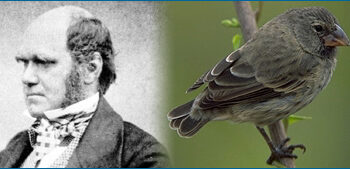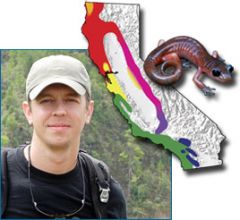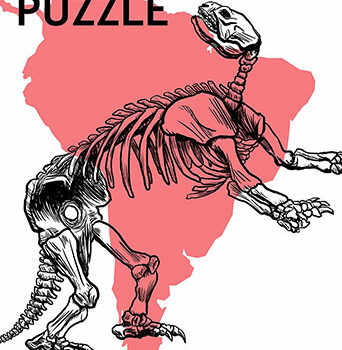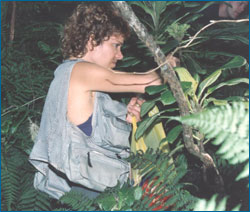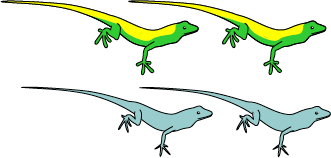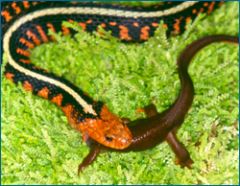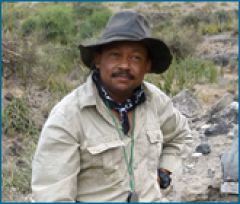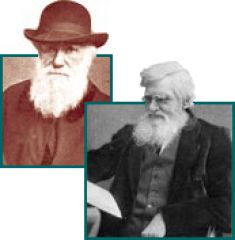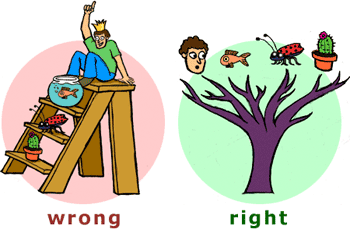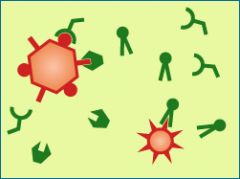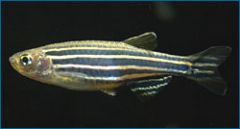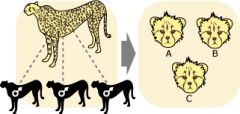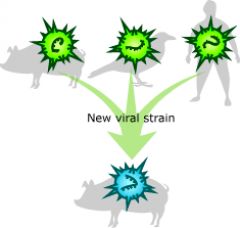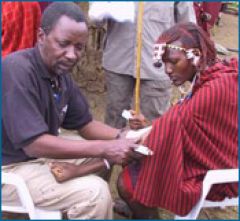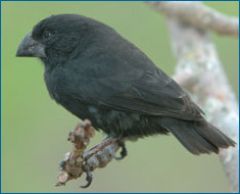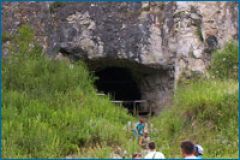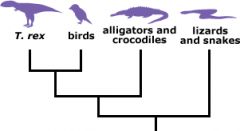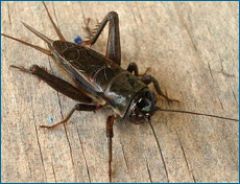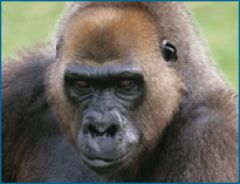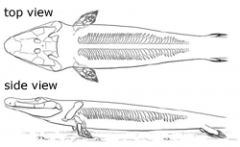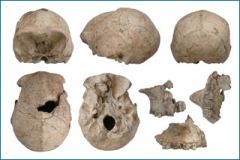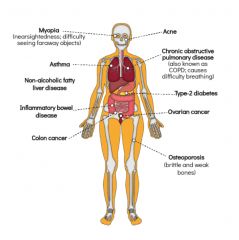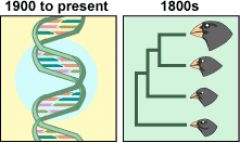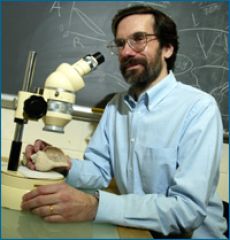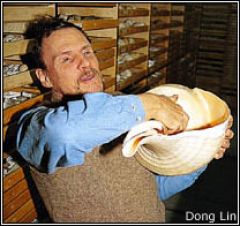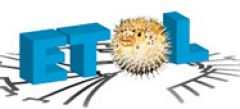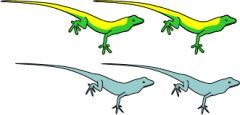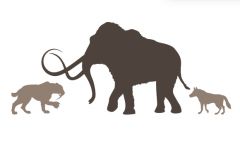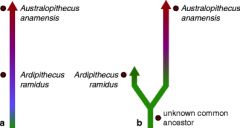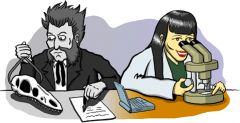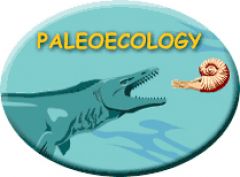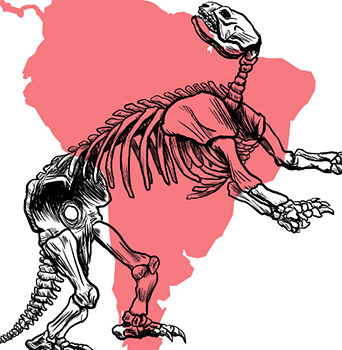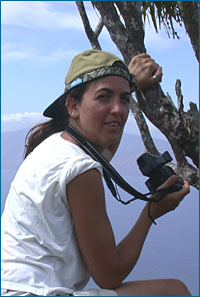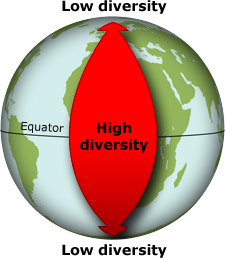Found 53 resources for the concept:
Scientific knowledge is open to question and revision as we come up with new ideas and discover new evidence. (P4, P6, NOS3)
¡Feliz cumpleaños número 200, Darwin!
Grade Level(s):
- 9-12
- 13-16
- General
Source:
- UC Museum of Paleontology
Resource type:
- Evo in the News article
Time: 30 minutes
Overview
Este 12 de febrero se cumplirían 200 años del nacimiento de Charles Darwin, y todo el mundo esta invitado a la fiesta. Numerosos grupos alrededor del mundo — desde niños en las escuelas primarias, hasta museos e iglesias — celebraran la ciencia de la evolución con conferencias públicas, clases, obras teatrales, exhibiciones artísticas y muchísimas galletas con forma de tortugas. 'Evolución en las noticias' de este mes contribuye a la celebración mediante la revisión de un tema cercano y querido por Darwin: los pinzones de Galápagos...
A closer look at a classic ring species: The work of Tom Devitt
Grade Level(s):
- 9-12
- 13-16
- General
Source:
- UC Museum of Paleontology
Resource type:
- Research profile
Time: 40 minutes
Overview
The Ensatina salamander has been extensively investigated because it is a ring species — a species that demonstrates how geography and the gradual accumulation of genetic differences factor into the process of speciation. Biologist Tom Devitt continues the more than 50 years of Ensatina research by applying new genetic techniques and asking new questions about this classic evolutionary example.
A Pleistocene Puzzle: Extinction in South America
Grade Level(s):
- 6-8
- 9-12
- General
- Student
Source:
- UC Museum of Paleontology
Resource type:
- Comic
Time: 20 minutes
Overview
In this comic, you'll follow the investigation of scientists Maria and Miguel as they solve a paleontological mystery. About 11,000 years ago, more than 80% of the large animal species in South America went extinct. Why did it happen? (Available in English and Spanish)
Aloha, spider style! The work of Rosemary Gillespie
Grade Level(s):
- 9-12
- 13-16
- General
Source:
- UC Museum of Paleontology
Resource type:
- Research profile
Time: one class period
Overview
This research profile follows Dr. Rosemary Gillespie to Hawaii as she evaluates hypotheses about the evolution of the colorful happy-face spider.
An Antipodal Mystery
Grade Level(s):
- 9-12
- 13-16
Source:
- Herreid, Clyde Freeman
Resource type:
- Classroom activity
Time: 1 to 2 hours, ideally split over multiple class periods
Overview
The discovery of the platypus had the scientific world in an uproar with its mammal-like and bird-like features. How was one to classify the platypus? This case study uses this issue to model the scientific process, with scientists arguing, debating, collecting more evidence, and revising their opinions as new data become available.
Anolis Lizards
Grade Level(s):
- 9-12
Source:
- Collins, Jennifer
Resource type:
- Lab activity
Time: Two class periods.
Overview
Students "take a trip" to the Greater Antilles to figure out how the Anolis lizards on the islands might have evolved.
Battling bacterial evolution: The work of Carl Bergstrom
Grade Level(s):
- 9-12
- 13-16
- General
Source:
- UC Museum of Paleontology
Resource type:
- Research profile
Time: 30-40 minutes
Overview
This research profile examines how the scientist Carl Bergstrom uses computer modeling to understand and control the evolution of antibiotic resistant bacteria in hospitals.
Biological warfare and the coevolutionary arms race
Grade Level(s):
- 9-12
- 13-16
- Advanced
- General
Source:
- UC Museum of Paleontology
Resource type:
- Article
Time: 45 minutes
Overview
The rough-skinned newt looks harmless enough but is, in fact, packed full of one of the most potent neurotoxins known to man. Find out how an evolutionary arms race has pushed these mild-mannered critters to the extremes of toxicity and how evolutionary biologists have unraveled their fascinating story.
CSI: Olduvai Gorge. The work of Jackson Njau
Grade Level(s):
- 9-12
- 13-16
Source:
- UC Museum of Paleontology
Resource type:
- Research profile
Time: 40 minutes
Overview
This research profile follows paleoanthropologist Jackson Njau as he investigates ancient predators, like crocodiles and large cats, in an effort to understand how these organisms shaped the evolution of our human ancestors.
Darwin and Wallace: Natural selection
Grade Level(s):
- 6-8
- 9-12
- General
Source:
- UC Museum of Paleontology
Resource type:
- Article
Time: 10 minutes
Overview
Darwin and Wallace came up with the idea of natural selection, but their idea of how evolution occurs was not without predecessors.
This article is located within History of Evolutionary Thought.
Darwin’s “extreme” imperfection?
Grade Level(s):
- 6-8
- 9-12
- 13-16
- General
Source:
- UC Museum of Paleontology
Resource type:
- Article
Time: 40 minutes
Overview
Darwin used the words "extreme imperfection" to describe the gappy nature of the fossil record - but is this really such a problem? This article delves into the topic of transitional fossils and explores what we have learned about them since Darwin's time.
This article appears at SpringerLink.
Evidencias de la Evolución: La ciencia de la evolución
Grade Level(s):
- 6-8
- 9-12
- General
Source:
- UC Museum of Paleontology
Resource type:
- Tutorial
Time: 30-40 minutes
Overview
Evo in the news: A chink in HIV’s evolutionary armor
Grade Level(s):
- 9-12
- 13-16
- General
Source:
- UC Museum of Paleontology
Resource type:
- Evo in the News article
Time: 20 minutes
Overview
Medical researchers have spent billions of dollars and many decades trying to develop an HIV vaccine but have, thus far, failed. Why is an HIV vaccine so elusive? This news brief from March 2007 explains how HIV's rapid rate of evolution challenges medicine and describes a new discovery that may allow vaccine developers to sidestep that evolution.
Evo in the news: A fish of a different color
Grade Level(s):
- 9-12
- 13-16
- General
Source:
- UC Museum of Paleontology
Resource type:
- Evo in the News article
Time: 15 minutes
Overview
This news brief, from February 2006, describes how a mutated zebrafish gene may help us understand human evolution and the genes underlying human skin color. Humans and zebrafish both inherited the same pigmentation gene from their common ancestor.
Evo in the news: Another perspective on cancer
Grade Level(s):
- 9-12
- 13-16
- General
Source:
- UC Museum of Paleontology
Resource type:
- Evo in the News article
Time: 20 minutes
Overview
This news brief, from October of 2007, describes the evolutionary underpinnings of cancer. Recognizing cancer as a form of cellular evolution helps explain why a cure remains elusive and points the way toward new treatments.
Evo in the news: Better biofuels through evolution
Grade Level(s):
- 9-12
- 13-16
- General
Source:
- UC Museum of Paleontology
Resource type:
- Evo in the News article
Time: 20 minutes
Overview
This news brief from April 2009 describes how synthetic biologists are using the process of directed evolution to improve the efficiency of biofuel production.
Evo in the news: Cheating cheetahs prosper
Grade Level(s):
- 9-12
- 13-16
- General
Source:
- UC Museum of Paleontology
Resource type:
- Evo in the News article
Time: 15 minutes
Overview
Biologists have discovered that female cheetahs consistently seek out multiple mates. This news brief, from July 2007, explains how the evolutionary implications of this behavior may help conservation efforts targeting these endangered animals.
Evo in the news: Conserving the kakapo
Grade Level(s):
- 9-12
- 13-16
- General
Source:
- UC Museum of Paleontology
Resource type:
- Evo in the News article
Time: 15 minutes
Overview
This news brief, from April 2006, chronicles how researchers are using evolutionary theory to guide their strategies for conserving a critically endangered parrot - with some impressive results!
Evo in the news: Evolution and the avian flu
Grade Level(s):
- 9-12
- 13-16
- General
Source:
- UC Museum of Paleontology
Resource type:
- Evo in the News article
Time: 10 minutes
Overview
This news brief, from November of 2005, describes the threat of avian flu. The stage is set for this virus to evolve into a strain that could cause a deadly global pandemic.
Evo in the news: Ghosts of epidemics past
Grade Level(s):
- 9-12
- 13-16
- General
Source:
- UC Museum of Paleontology
Resource type:
- Evo in the News article
Time: 20 minutes
Overview
HIV and malaria both constitute global health threats, respectively affecting more than 30 million and 200 million people worldwide. This news brief from October 2008 describes new research that reveals an unexpected evolutionary link between the two.
Evo in the news: Got lactase?
Grade Level(s):
- 9-12
- 13-16
- Advanced
- General
Source:
- UC Museum of Paleontology
Resource type:
- Evo in the News article
Time: 20 minutes
Overview
The ability to digest milk is a recent evolutionary innovation that has spread through some human populations. This news brief from April 2007 describes how evolution has allowed different human populations to take advantage of the nutritional possibilities of dairying and links evolution with the prevalence of lactose tolerance among people of different ethnicities.
Evo in the news: Happy 200th, Darwin!
Grade Level(s):
- 9-12
- 13-16
- General
Source:
- UC Museum of Paleontology
Resource type:
- Evo in the News article
Time: 30 minutes
Overview
This news brief, from February 2009, celebrates Darwin's bicentennial by examining what we've learned about the evolution of the Galapagos finches since Darwin's time.
Evo in the news: Making sense of ancient hominin DNA
Grade Level(s):
- 9-12
- 13-16
- Advanced
- General
Source:
- UC Museum of Paleontology
Resource type:
- Evo in the News article
Time: 10 minutes
Overview
In March 2010 German researchers announced that they had managed to extract DNA from the 40,000 year old fossil bone from a child discovered in a Siberian cave and that it didn't match up to the known genetic sequences of either humans or Neanderthals! This news brief examines the evidence in more detail and considers what that evidence might — or might not — mean about such claims.
Evo in the news: More than morphology
Grade Level(s):
- 9-12
- 13-16
- General
Source:
- UC Museum of Paleontology
Resource type:
- Evo in the News article
Time: 15 minutes
Overview
This news brief, from August 2006, describes recent research on T. rex, with a special focus on how paleontologists move beyond the shape of the animal's bones to learn about aspects of its life that don't fossilize very well: its physiology, sensory abilities, and population dynamics.
Evo in the news: Omicron and the case of the hidden evolution
Grade Level(s):
- 9-12
- 13-16
- General
Source:
- UC Museum of Paleontology
Resource type:
- Evo in the News article
Time: 30 min
Overview
This news brief from January 2022, explores the evolutionary mystery at the heart of the Omicron COVID-19 surge.
Evo in the news: Quick evolution leads to quiet crickets
Grade Level(s):
- 9-12
- 13-16
- General
Source:
- UC Museum of Paleontology
Resource type:
- Evo in the News article
Time: 20 minutes
Overview
The tropical island of Kauai has always been a quiet place, but now it may be getting even more quiet. This news brief, from December 2006, reveals how Kauai's cricket population has evolved into a "chirpless" variety in just a few years.
Evo in the news: Spreading disease on evolutionary timescales
Grade Level(s):
- 9-12
- 13-16
- General
Source:
- UC Museum of Paleontology
Resource type:
- Evo in the News article
Time: 10 minutes
Overview
Most infectious diseases that we are familiar with are passed from human to human; however, on evolutionary timescales, pathogens don't necessarily respect species boundaries. This news brief from November 2010 examines a recently discovered case of disease swapping among species involving a deadly strain of malaria.
Evo in the news: What has the head of a crocodile and the gills of a fish?
Grade Level(s):
- 9-12
- 13-16
- General
Source:
- UC Museum of Paleontology
Resource type:
- Evo in the News article
Time: 15 minutes
Overview
This news brief, from May 2006, reviews what is likely to be the most important fossil find of the year: Tiktaalik helps us understand how our own ancestors crawled out of the water and began to walk on dry land.
Evo in the news: When it comes to evolution, headlines often get it wrong
Grade Level(s):
- 9-12
- 13-16
- General
Source:
- UC Museum of Paleontology
Resource type:
- Evo in the News article
Time: 15 minutes
Overview
Newly discovered fossils are prompting some scientists to consider a minor revision of the relationships shown on the human family tree. This news brief from September 2007 clarifies the occasionally misleading news coverage of the story.
Evolution and health: What is a mismatch disease?
Grade Level(s):
- 9-12
Source:
- BiteScis
Resource type:
- Classroom activity
Time: 50 minutes
Overview
In this reading-, writing-, and discussion-based activity, students learn about how changes in the environment can influence the phenotype of organisms. More specifically, students will be investigating the concept of a mismatch disease and how it relates to many present human phenotypes that are no longer beneficial.
Great Fossil Find
Grade Level(s):
- 6-8
- 9-12
- 13-16
Source:
- ENSI
Resource type:
- Classroom activity
Time: 40 minutes
Overview
Students are taken on an imaginary fossil hunt and hypothesize as to the identity of the creature they discover. Students revise their hypotheses as new evidence is "found."
History of evolutionary thought
Grade Level(s):
- 9-12
- General
Source:
- UC Museum of Paleontology
Resource type:
- Article
Time: Varies
Overview
In this section, you will see how study in four disciplinary areas — Earth's history, life's history, mechanisms of evolution, and development and genetics — has contributed to our current understanding of evolution.
How boogieing birds evolved: The work of Kim Bostwick
Grade Level(s):
- 9-12
- 13-16
- General
Source:
- UC Museum of Paleontology
Resource type:
- Research profile
Time: 30 minutes
Overview
This research profile follows ornithologist Kim Bostwick through the jungles of Ecuador and the halls of museums as she investigates the evolution of an exotic bird's complex mating dance.
How to survive a mass extinction: The work of David Jablonski
Grade Level(s):
- 9-12
- 13-16
- General
Source:
- UC Museum of Paleontology
Resource type:
- Research profile
Time: 40 minutes
Overview
Through detailed analysis of patterns in the fossil record, scientist David Jablonski reconstructs the rules that helped dictate who lived and died in past mass extinctions. This research profile describes his surprising discoveries and their disturbing implications for the biodiversity crisis today.
Interview: Geerat Vermeij on the Fossil record
Grade Level(s):
- 9-12
- Advanced
- General
Source:
- California Academy of Sciences
Resource type:
- Interview with Scientist
Time: 20-30 minutes
Overview
This interview with MacArthur Fellow and paleobiologist, Geerat Vermeij, covers much ground, including adaptations in the mollusks he studies, evolutionary arms races, punctuated equilibrium, extinctions, macroevolution, and the value of diversity.
Investigating a Deep Sea Mystery
Grade Level(s):
- 9-12
Source:
- ETOL
Resource type:
- Lab activity
Time: 4-5 class periods
Overview
In this lab activity, students examine authentic morphological and phylogenetic data of three fish families and then pose and test alternative hypotheses about the fishes' classification.
Island biogeography and evolution: Solving a phylogenetic puzzle using molecular genetics
Grade Level(s):
- 9-12
- 13-16
Source:
- Filson, R.P.
Resource type:
- Lab activity
Time: Two full class periods
Overview
Students focus on the evolution of three species of lizards using real data sets — geographical and geological data, then morphology, and finally molecular data — to determine possible phylogenetic explanations.
Lines of evidence: The science of evolution
Grade Level(s):
- 6-8
- 9-12
- General
Source:
- UC Museum of Paleontology
Resource type:
- Tutorial
Time: 30-40 minutes
Overview
The theory of evolution is broadly accepted by scientists — and for good reason! Learn about the diverse and numerous lines of evidence that support the theory of evolution.
McKittrick Fossil Find Classroom Activity
Grade Level(s):
- 3-5
- 6-8
- 9-12
Source:
- UC Museum of Paleontology
Resource type:
- Classroom activity
Time: 50 minutes
Overview
In this lesson, students play the roles of paleontologists on a dig. They “unearth” a few fossils at a time and attempt to reconstruct the animal the fossils represent.
Mejores biocombustibles gracias a la evolución
Grade Level(s):
- 9-12
- 13-16
- General
Source:
- UC Museum of Paleontology
Resource type:
- Evo in the News article
Time: 20 minutes
Overview
Actualmente, la mayoría de nosotros llenamos nuestro tanque de gasolina con combustibles fósiles, es decir, restos de plantas y animales que murieron muchos millones de años atrás y eventualmente se convirtieron en petróleo — pero, por supuesto, esto no puede perdurar para siempre. El petróleo es un recurso limitado y en algún momento se va a terminar. Para ayudar a solucionar este problema, muchos científicos, políticos, gente de negocios y ciudadanos preocupados han puesto sus esperanzas en los biocombustibles...
Names, they are a-changing
Grade Level(s):
- 9-12
- 13-16
Source:
- Evolution: Education and Outreach
Resource type:
- Article
Time: 30 minutes
Overview
The popular press often describes scientific controversies regarding which species ancient hominin fossils represent and how they are related to one another. How should students interpret the frequent name changes experienced by our extinct relatives? What should they make of headlines that trumpet major revisions of the branching patterns on our limb of the tree of life? This article will help teachers develop instruction surrounding these issues, discourage misconceptions, and help students interpret media coverage in light of the process of science.
This article appears at SpringerLink.
Natural selection from the gene up: The work of Elizabeth Dahlhoff and Nathan Rank
Grade Level(s):
- 9-12
- 13-16
- Advanced
Source:
- UC Museum of Paleontology
Resource type:
- Research profile
Time: 30 minutes
Overview
Find out how we investigate evolutionary adaptations by following two scientists and their team as they figure out how the willow leaf beetle survives in different climates.
Nature of science
Grade Level(s):
- 6-8
- 9-12
- General
Source:
- UC Museum of Paleontology
Resource type:
- Tutorial
Time: 20-30 minutes
Overview
Understanding how science works allows one to easily distinguish science from non-science. Thus, to understand biological evolution, or any other science, it is essential to begin with the nature of science.
Omicron y el caso de la evolución escondida
Grade Level(s):
- 9-12
- 13-16
- General
Source:
- UC Museum of Paleontology
Resource type:
- Evo in the News article
Time: 30 min
Overview
Durante el último mes, las cepas del SARS-CoV-2 Omicron han dominado los noticiarios del mundo. Esta variante de rápida transmisión ha llevado a limitar viajes, a cancelar planes de vacaciones, al agotamiento de los kits de pruebas, a la vuelta de los confinamientos, y además a un asombroso número de nuevos casos de COVID-19. Los científicos rápidamente se han puesto a estudiar Omicron, intentando entender qué tan rápido se transmite, qué tanto nos enferma, y si es resistente a los tratamientos, a las vacunas, y a los anticuerpos de infecciones de COVID previas. Necesitamos revisar todas estas cuestiones porque Omicron es muy diferente de otras cepas de coronavirus. Omicron ha acumulado más de 50 nuevas mutaciones en comparación con la cepa que empezó la pandemia. Además Omicron no es un descendiente de la cepa Delta, responsable de la anterior ola de infecciones. De hecho, Omicron es tan diferente de otras variantes que parece que ha estado evolucionando por su cuenta durante muchos meses. Y esto nos conduce a otro misterio que los científicos están tratando de resolver: ¿dónde estaba Omicron escondido mientras toda esta evolución tenía lugar?
Proposing the Theory of Biological Evolution
Grade Level(s):
- 9-12
Source:
- National Academy of Sciences
Resource type:
- Article
Time: Three class periods
Overview
Students read short excerpts of original statements on evolution from Jean Lamarck, Charles Darwin, and Alfred Russel Wallace to gain historical perspective and an understanding of the nature of science.
Stories from the Fossil Record
Grade Level(s):
- 6-8
- 9-12
Source:
- UC Museum of Paleontology
Resource type:
- Online activity or lab
Time: One to two class periods
Overview
This web-based module provides students with a basic understanding of how fossils can be used to interpret the past.
The Checks Lab
Grade Level(s):
- 9-12
- 13-16
Source:
- ENSI
Resource type:
- Classroom activity
Time: One class period
Overview
Students construct plausible scenarios using bank checks to learn how human values and biases influence observation and interpretation.
The Monterey Pine through geologic time
Grade Level(s):
- 9-12
- Advanced
- General
Source:
- Perry, Frank
Resource type:
- Article
Time: 30 minutes
Overview
Understanding the evolutionary history of the Monterey Pine may help us conserve this species.
Un rompecabezas Pleistoceno: Extinctión en América del Sur
Grade Level(s):
- 6-8
- 9-12
- General
- Student
Source:
- UC Museum of Paleontology
Resource type:
- Comic
Time: 20 minutes
Overview
En este comic podrás seguir la investigación que hicieron María y Miguel para resolver un misterio paleontológico. Hace más de 11000 años, más del 80% de las especies de grandes animales de Sudamérica se extinguieron. ¿Por qué pasó? (Disponible en inglés, español y portugués.)
Using trees to understand plants: The work of Chelsea Specht
Grade Level(s):
- 9-12
- 13-16
- General
Source:
- UC Museum of Paleontology
Resource type:
- Research profile
Time: 30 minutes
Overview
This research profile follows scientist Chelsea Specht as she pieces together the evolutionary history of tropical plants and their pollinators--and in the process, tries to figure out how to conserve endangered species.
Visualizing life on Earth: Data interpretation in evolution
Grade Level(s):
- 9-12
- 13-16
Source:
- UC Museum of Paleontology
Resource type:
- Online activity or lab
Time: 2 hours
Overview
This web-based module leads students through an exploration of the patterns in the diversity of life across planet Earth. Students are scaffolded as they practice data interpretation and scientific reasoning skills.
Webcast: The science of evolution
Grade Level(s):
- 9-12
- General
Source:
- New York Times
Resource type:
- Video
Time: 10 minutes
Overview
Evolutionary biologist Sean Carroll introduces the field of Evo-Devo, using examples from fruit flies, butterflies, and icefish to explain how this research is transforming our understanding of evolution.
This video is available from the New York Times website.
Xenosmilus
Grade Level(s):
- 3-5
- 6-8
- 9-12
Source:
- UC Museum of Paleontology
Resource type:
- Classroom activity
Time: ~40 min
Overview
Students play the roles of paleontologists on a dig. They "unearth" a few fossils at a time and attempt to reconstruct the animal the fossils represent.

